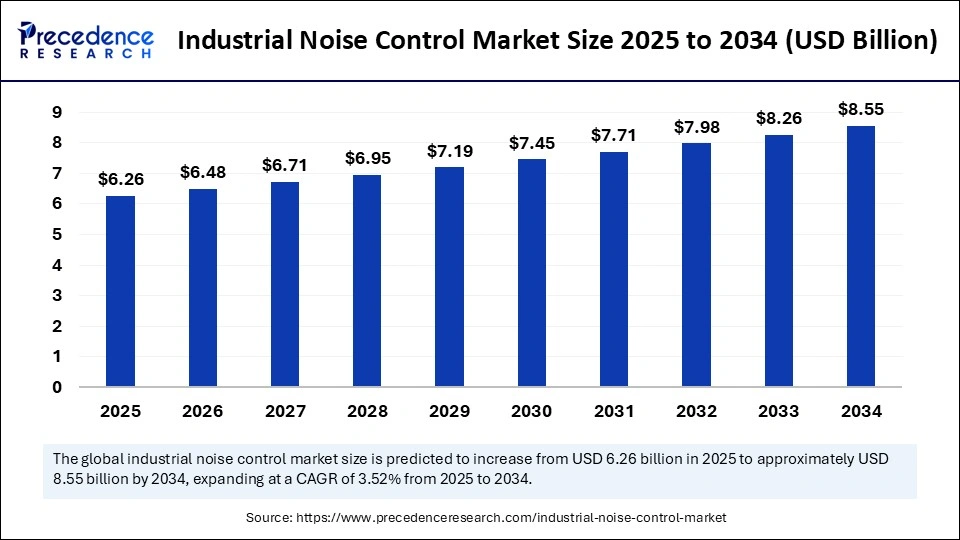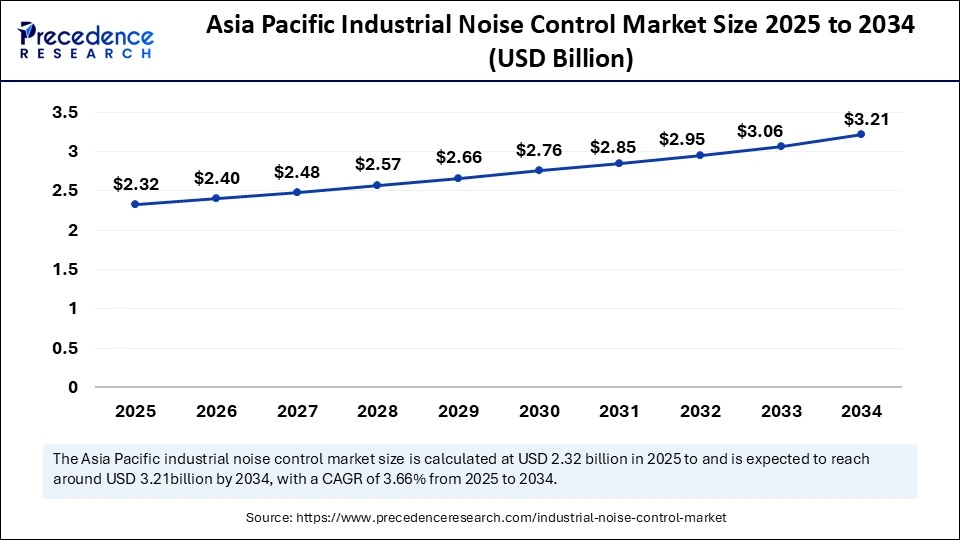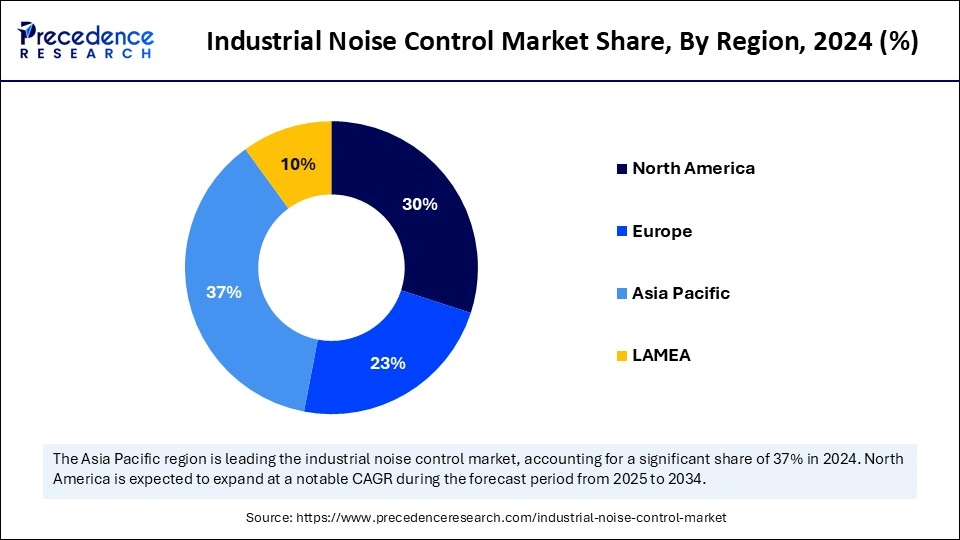List of Contents
What is Industrial Noise Control Market Size?
The global industrial noise control market size accounted for USD 6.26 billion in 2025 and is predicted to increase from USD 6.48 billion in 2026 to approximately USD 8.55 billion by 2034, expanding at a CAGR of 3.52% from 2025 to 2034. The growth of the market is driven by increasing industrial activity and rising demand for cleaner and safer work environments. Moreover, rising noise pollution leads to a greater demand for noise control solutions.

Market Highlights
- Asia Pacific dominated the industrial noise control market with the largest revenue share of 37% in 2024.
- North America is expected to grow at the fastest rate in the market during the forecast period.
- By product, the noise control enclosures segment held the dominant share of the market in 2024.
- By product, the silencers segment is projected to grow at a significant CAGR during the projected period.
- By material, the polymers and composite segment dominated the market in 2024.
- By material, the metal segment is anticipated to grow at a significant rate in the upcoming period.
- By end-user, the industrial machinery segment captured the largest market share in 2024.
- By end-user, the automotive industry segment is observed to expand at the fastest rate between 2025 and 2034.
How is Innovation Impacting the Market?
Artificial intelligence is transforming the industrial noise control market by allowing real-time noise monitoring, predictive maintenance, and adaptive noise control, resulting in improved efficiency and effectiveness. AI algorithms can analyze data from Internet of Things-connected sensors to identify noise patterns, predict suspected issues, and recommend optimal solutions for automatically adjusting noise barriers based on dynamic noise levels. Furthermore, AI can recognize areas with high noise levels, allowing authorities and urban planners to optimize noise reduction campaigns that can be integrated into smart city infrastructure to monitor and manage noise pollution effectively.
- In October 2024, New York City implemented a smart noise monitoring system that leverages 5G, AI, and cloud computing. Sensors placed around the city collect noise data, further analyzed using AI algorithms to identify sources and patterns. The cloud stores this data and makes it accessible for city planners and policymakers for effective noise reduction strategies.(Source: https://www.irjmets.com)
Rising demand for Advanced Industrial Noise Control Solutions
The industrial noise control market comprises products and services designed to reduce noise pollution in industrial settings by protecting workers and mitigating community noise. This includes products like soundproofing materials, noise barriers, enclosures, and other acoustic solutions. The market is witnessing rapid growth due to rising industrialization, rigorous environmental regulations, and growing awareness of noise-induced health issues. Industrial noise control solutions find applications across various industries. The rising demand for smart noise control solutions and growing industrial activities in urban areas further contribute to market expansion.
What are the Key Trends in the Industrial Noise Control Market?
- Rapid Industrialization and Manufacturing Growth: Rapid industrialization leads to increased industrial activities, and manufacturing processes generate more noise and therefore necessitate noise control measures.
- Workplace Safety and Productivity Concern: Nowadays, companies are increasingly prioritizing employee health and productivity, leading to greater investment in noise control measures. Additionally, reducing noise levels in the workplace improves employee health and safety, as well as productivity.
- Growing Awareness of Noise Concerns: Growing awareness of the negative health and social impacts of noise pollution and its impact on surrounding communities is resulting in increased demand for noise control in industrial areas.
- Technological Advancements: The development of innovative and cost-effective noise control technologies, especially more effective and efficient acoustic material developments for noise control systems, is spurring market growth.
- Regulatory Compliance: Stricter workplace noise exposure limits and regulations are propelling the necessity for noise control solutions. Industries must comply with noise regulations by adopting noise control technologies and equipment.
Market Outlook
- Industry Growth Offerings- The market is growing due to stricter safety regulations, rising industrial activity, and increasing awareness of noise-related health risks. Demand for advanced acoustic barriers, enclosures, and smart monitoring technologies is accelerating adoption across manufacturing, construction, and energy sectors.
- Global Expansion- Global expansion of the industrial noise control market is driven by rapid industrialization, stricter environmental noise regulations, and growing urban manufacturing hubs. Increased adoption of advanced acoustic materials, smart noise-monitoring systems, and sustainable soundproofing solutions is further broadening the market worldwide.
- Startup ecosystem- The industrial noise control startup ecosystem is expanding as new companies focus on smart acoustic monitoring, AI-based noise prediction, sustainable soundproofing materials, and modular noise-control solutions. Rising industrial safety demands and urban noise challenges are attracting innovation and investment in this segment.
Market Scope
| Report Coverage | Details |
| Market Size in 2025 | USD 6.26 Billion |
| Market Size in 2026 | USD 6.48 Billion |
| Market Size by 2034 | USD 8.55 Billion |
| Market Growth Rate from 2025 to 2034 | CAGR of 3.52% |
| Dominating Region | Asia Pacific |
| Fastest Growing Region | North America |
| Base Year | 2024 |
| Forecast Period | 2025 to 2034 |
| Segments Covered | Product, Material, End-User, and Region |
| Regions Covered | North America, Europe, Asia-Pacific, Latin America, and Middle East & Africa |
Market Dynamics
Drivers
Increasing Urbanization and Industrialization
The primary factor driving the growth of the industrial noise control market is increasing urbanization and industrialization, resulting in more noise pollution from factories, manufacturing units, construction sites, and other industrial environments. The need for industrial noise control solutions is rising to control noise pollution and protect workers' health. Moreover, people and industry stakeholders have become more aware of the negative health effects of noise pollution. As a result, regulatory bodies have imposed stricter regulations to reduce noise pollution, boosting the need for noise-mitigating solutions.
Restraint
Higher Cost
Implementing noise control solutions requires substantial investments, creating barriers for small and medium-sized enterprises. Moreover, these solutions require regular maintenance, which raises operational costs. Designing and handling noise control solutions require specialized skills, creating challenges in the market. Key players must focus on developing cost-effective and durable noise control solutions, including innovative materials and technologies.
Opportunity
Integration of Advanced Technologies
The key opportunity in the industrial noise control market lies in the integration of advanced technologies, such as IoT and AI, for real-time monitoring, predictive maintenance, and adaptive noise control. This is further attributed to more efficient and effective noise reduction strategies. IoT sensors continuously collect noise data from various sources within an industrial facility, and AI algorithms can analyze this data to recognize noise patterns, predict potential problems, and suggest optimal solutions.
Segment Insights
Product Insights
The noise control enclosures segment held a dominant share of the industrial noise control market in 2024 because they effectively address noise at the source by offering a direct and robust solution for mitigating unwanted sounds through physically isolating noise sources like machinery and equipment. This approach is specifically crucial for industries where loud machinery is subjected to strict regulations. Increased concerns over worker safety and the necessity for quieter operations bolstered the growth of the segment. Enclosures enable businesses to comply with regulations and protect workers from potential hearing damage and other health risks by improving their overall safety and productivity.
The silencers segment is projected to grow at a significant CAGR during the projected period. This is mainly due to growing awareness of the effects and impacts of noise pollution, advancements in acoustic materials and designs, and implementation of stricter noise pollution regulations, forcing industries to invest in noise control solutions like silencers to ensure compliance. Noise pollution can also negatively impact local communities. Silencers enable the reduction of noise emissions, fostering a more pleasant environment for both workers and residents. Furthermore, continuous research and innovation are leading to more effective acoustic materials and designs by making silencers even more efficient and affordable.
Material Insights
The polymers and composite segment dominated the industrial noise control market with the largest share in 2024. This is mainly due to their superior soundproofing properties compared to other materials like glass, metal, and fabric. Therefore, they facilitate better noise absorption and vibration-damping capabilities, which are crucial for noise regulations and improving worker comfort in industrial settings. Additionally, these materials are not only versatile for customization in various noise control applications but also provide good durability for demanding industrial environments.
The metal segment is anticipated to grow at a significant rate in the upcoming period, owing to its easy availability, cost-effectiveness, and ease of use. The segment growth is further attributed to the rising demand for noise control solutions in various industrial settings such as manufacturing, power generation, and construction. Additionally, metals are more durable and resistant to harsh industrial environments, ensuring the long-term performance of noise control solutions. Also, metals are versatile and can be easily shaped and fabricated into various forms, such as barriers, enclosures, and silencers, which are essential for industrial noise control applications.
End-User Insights
The industrial machinery segment captured the largest share of the industrial noise control market in 2024. This is mainly due to the inherently high noise levels generated by industrial processes and equipment. This dominance is further driven by rapid industrialization and urbanization, resulting in a higher demand for noise control solutions. Furthermore, the expansion of manufacturing activities, coupled with the need for quieter operations to ensure worker safety and productivity, drives the need for noise control solutions in industrial machinery.
The automotive industry segment is observed to expand at the fastest rate during the forecast period. The growth of the segment is attributed to the increasing global demand for vehicles. Rapid shift toward electric vehicles also necessitates specialized acoustic solutions to address unique noise challenges. Additionally, automakers are increasingly prioritizing a quieter and more comfortable driving experience, spurring the demand for noise reduction technologies and materials. Stringent regulations to reduce noise pollution from the automotive industry support segmental growth.
Regional Insights
Asia Pacific Industrial Noise Control Market Size and Growth 2025 to 2034
Asia Pacific industrial noise control market size is exhibited at USD 2.32 billion in 2025 and is projected to be worth around USD 3.21 billion by 2034, growing at a CAGR of 3.66% from 2025 to 2034.

Asia Pacific's Stronghold on the Industrial Noise Control Market
Asia Pacific accounted for the the major revenue share of 37% in 2024. This is because of the rapid increase in manufacturing and industrial operations in countries like China and India, leading to higher noise levels and a greater demand for noise control measures. A growing population and urbanization encourage a strong demand for noise control solutions to protect workers and local communities. Furthermore, governments around the region are actively fostering industrial development as well as executing policies to control noise pollution. These policies frequently include noise level regulations and incentives for businesses to adopt noise control technologies, along with funding for research and development in the field.
China Industrial Noise Control Market Trends
China is experiencing rapid growth in the market. This is mainly due to rapid industrialization, urbanization, and rising government regulations focused on noise pollution. Consequently, there is an increasing demand for soundproofing solutions in both residential and commercial buildings. Given that China has a massive manufacturing sector, it necessitates the use of industrial noise control systems to ensure worker welfare and comply with regulations.
India: A Hub for the Development of Effective Sound Insulation Solutions
India is expected to grow at a lucrative rate in the industrial noise control market, owing to increasing infrastructure development projects, including the construction of residential, commercial, and institutional buildings. This boosts the demand for effective sound insulation solutions. Moreover, growing awareness about the negative impacts of noise pollution on health and productivity is prompting the use of sound insulation in various applications, from construction to the automotive industry.

How is North America Influencing the Industrial Noise Control Market?
North America region is expected to witness the fastest growth during the forecast period. This is due to the strong focus of the region on workplace safety regulations, a massive industrial base, and increased awareness of employee health. North America has a robust regulatory framework for noise control in industrial settings, encouraging the adoption of noise control measures to protect the health of workers. Furthermore, the remarkable industrial sector of the region leads to a high demand for noise control solutions to address noise pollution from machinery and processes.
The U.S. Industrial Noise Control Market Trends
The U.S. plays a significant role in the industrial noise control market. This is driven by the large manufacturing base, especially in automotive and aerospace, which contributes to high noise pollution, leading to the necessity of effective noise control solutions. The U.S. manufacturers are actively developing innovative, cost-effective materials and technologies to address this demand. Furthermore, the Noise Pollution and Abatement Act and other federal and state regulations related to noise pollution, occupational health, and safety contribute to the demand for noise control solutions.
- In January 2023, CECO Environmental Corp announced that it had completed the acquisition of Wakefield Acoustics, Ltd, a UK-based design and manufacturing firm specializing in advanced industrial, commercial, and environmental noise control systems. This acquisition strengthens CECO in the industrial silencing and noise attenuation segments by opening new solutions and expanding its reach into new markets.(Source: https://www.newswire.ca)
Europe: A Notably Growing Region
Europe is expected to grow at a notable rate in the foreseeable future. This is due to its robust industrialization, dense urban areas, and growing emphasis on environmental regulations and public health. There are a significant number of factories, manufacturing plants, and industrial facilities that produce considerable noise pollution. The region is a hub for developing innovative noise control technologies and has a strong emphasis on research and development, making innovative solutions and advanced equipment for industrial noise reduction practices.
What Factors are Powering the Expansion of the UK Noise Control Market?
The UK market is growing due to stricter workplace safety regulations, increasing enforcement of noise exposure limits, and rising awareness of employee health and productivity. Expanding manufacturing, construction, and energy sectors are driving higher demand for acoustic barriers, enclosures, and smart noise-reduction systems. Additionally, urban industrial activities and community noise concerns are pushing companies to adopt advanced noise-control technologies, supporting steady market growth.
Key Players in Industrial Noise Control Market and their Offerings
- eNoiseControl: Offers sound blankets, acoustic panels, soundproof curtains, steel enclosures, and full noise-control consulting for industrial and environmental settings.
- SysTech Design Inc.: Provides industrial ventilation systems, fan silencers, acoustic enclosures, exhaust silencers, and noise analysis to meet OSHA/NIOSH standards.
- Ventac Co. Ltd.: Designs and manufactures turnkey noise control solutions for vehicles and industries, including sound insulation, enclosures, attenuators, and acoustic testing.
- Envirotech Systems Ltd.: Specializes in acoustic engineering, offering noise barriers, industrial enclosures, acoustic doors, test booths, and custom soundproofing solutions.
Recent Developments
- In March 2024, Noise Barriers (NB) presented the QuietSwing Alexis Door, a groundbreaking addition that features a patented concealed hinge design to maintain a clean aesthetic in any space. This innovative door system marks a significant leap in noise control solutions by combining cutting-edge design, impeccable aesthetics, and unparalleled acoustic performance, such as in classrooms, performance halls, and conference rooms, ensuring effortless operation. (Source: https://www.noisebarriers.com)
- In December 2024, SoundPLAN launched version 6.0 of its noise mapping software. SoundPLANessential is designed for standard noise reports for smaller-scale developments or occasional projects. The software leverages to calculate, document, and visualise noise propagation from roads, railways, industrial sources, and parking lots by providing reliable tabular and graphical results for a standard environmental noise calculation. (Source: https://www.architectandinteriorsindia.com)
- In September 2024, KPS Capital Partners announced that it had signed a definitive agreement to acquire Catalyst Acoustics Group, Inc. This collaboration offers best-in-class critical acoustic, seismic, vibration, and noise control solutions across diverse end-use industries.
(Source: https://www.kpsfund.com) - In October 2023, Hummble launched active noise cancelling system for Heating and Refrigeration, the world's first active noise reduction system tailored for heating and refrigeration equipment. It leveraged advanced Active Noise Cancelling (ANC) technology to address the pervasive issue of tonal compressor noise in heat pumping products. (Source: https://refindustry.com)
Segments Covered in the Report
By Product
- Silencers
- Acoustic Louvres
- Noise Control Enclosures
- Curtains and Barrier Walls
- Others
By Material
- Polymers and Composite
- Metal
- Fabric
- Glass
- Wood
By End-User
- Industrial Machinery
- Gas Turbine
- Textile Machinery
- Others
- Metal Processing
- Automotive Industry
- Construction and Mining
- Commercial
- Others
By Region
- North America
- Europe
- Asia-Pacific
- Latin America
- Middle East and Africa
For inquiries regarding discounts, bulk purchases, or customization requests, please contact us at sales@precedenceresearch.com
Frequently Asked Questions
Ask For Sample
No cookie-cutter, only authentic analysis – take the 1st step to become a Precedence Research client



